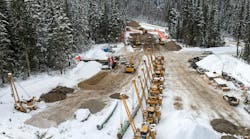J.C. Pratsch
Petroleum Geologist
Houston
Geochemical parameters today are part of many regional basin evaluations, even of local oil and gas prospects. The underlying petroleum system concept is widely accepted by industry. Main reasons are a continuously improving data base, better interpretation techniques and experiences, and a strengthening realization that the history of oil and gas is at least as important as the history of traps and reservoirs.
This is true also in the offshore Gulf Coast region (Fig. 1 [16622 bytes]). However, major exploration efforts to locate the "best" offshore acreage so far have concentrated on techniques designed to define "best" areas on the basis of early (pre-drilling) reservoir and trap prediction. The tools used were high-cost regional 3D seismic surveys, high-intensity airborne magnetic surveys, high-quality gravity surveys, and shipborne bathymetric surveys. In these approaches areas were sought that contain an above-average potential to trap sand-containing clastics, such as (relatively shallow) regional structural lows that lie between flanking salt diapir walls.
A critical assessment of oil and gas migration processes may introduce changes in such exploration philosophies: If we knew the location and timing of preferred oil and gas migration pathways, any prospect inside and near a preferred migration pathway will carry a higher chance of success than others. Selection of prospective acreage in areas of preferred oil and gas migration even will influence bidding strategies prior to necessary high investments. Definition of traps and preferred sand sedimentation areas will remain important but secondary parameters.
Oil, gas origins
Oil in the Gulf Coast offshore region has been or is being generated from Jurassic, Cretaceous, and/or Paleogene source beds; no quantitatively important Neogene (Miocene and younger) mature oil source beds are known or expected in the region.1-10 Gas has been generated thermally from the same (oil) source beds, and biogenically from Neogene gas source beds.11-12
These facts introduce a number of practically important consequences (Fig. 2 [18546 bytes]):
- All oil and much gas may have migrated from 20,000 to more than 40,000 ft vertically, and probably as much as 15-20 miles laterally.
- Initial generation of oil and of much gas has occurred from Late Cretaceous time (from Jurassic sources) to Mid-Miocene (from Paleogene sources).
- Early (pre-Mid-Mio- cene) generated oil and gas may have stayed in the source bed; or, they migrated into nearby reservoirs of pre-Mid-Miocene ages. These are the Gulf Coast "primary fields."6 These hydrocarbons are still today in their original reservoirs (Fig. 2 [18546 bytes]); they may also have migrated meanwhile into younger post-Mid-Miocene reservoirs where they formed the Gulf Coast "secondary fields" (Fig. 2 [18546 bytes], left side).6 These secondary fields are being produced today, mainly in the Texas-Louisiana shelf area (Fig. 1 [16622 bytes]).
- Where maturation of oil/gas source beds is geologically young (of Neogene age), like in the deepwater area (Fig. 1 [16622 bytes]; Fig. 2 [18546 bytes], right side) oil and gas are generated (geologically speaking) today. Here oil and gas migrate mainly vertically toward the surface. Traps exist against faults, against diapir flanks, and in relatively shallow basins formed by salt withdrawal and by faulting ("primary fields").
- Primary oil and gas fields are controlled by deep structure expressed at deep Mesozoic and Paleogene levels. Such trapping structures may even be related to basement structure. Thus, primary oil and gas field areas and generating depocenters may well be shown on regional basement structure maps.
- Deeply subsided Mesozoic and Paleogene source beds have reached their overmaturation stage from Mid-Miocene to recent times (Fig. 2 [18546 bytes], left side); they today lie below their respective oil window. Gas and condensate generated geologically recently now migrate into reservoirs correlative with source beds, or are leaking into younger reservoirs. This may lead to a higher condensate-gas content of deeper reservoirs in the Gulf Coast offshore even where such reservoirs are still inside their oil window.
Seismic data have not yet generated regional deep (or basement) structure maps required. Regional magnetic and gravity data, however, have been utilized to map regional structure maps across the Gulf Coast basin. Many regional structural magnetic-basement features in the offshore areas are already known to have affected oil and gas field distribution.6 This is actually not surprising: basement features (highs, lows, fault/hinge zones) are known to control the location of field concentrations and of field trends in the onshore area, and equal relations exist in the offshore area.
Oil and gas migration processes include hydrocarbon buoyancy in a static or mobile water environment (major contributor), and hydrocarbon solution in water (minor contributor). The energy required for hydrocarbon migration is obtained from hydrocarbon buoyancy itself (major contributor), from clay re-crystallization, water heat-expansion (minor contributor), and others.
All of this permits to predict major oil and gas migration directions:6 Hydrocarbons migrate mainly perpendicular to existing subsurface isobars or parallel to subsurface pressure gradients. Isobars in turn are generally parallel to regional structure contours; minor deviation from this rule will occur in areas of variable hydrodynamic pressure or of overpressured cells.
In practical day to day exploration, hydrocarbon migration directions and preferred migration pathways can be determined by constructing preferred-pathway locations. Horizons mapped near the regional oil and gas carrier beds are best suited for such an analysis. Maps generated at horizons farther away from the carrier beds may in most cases give similar results as long as deep regional structure is imaged. This should encourage to initially use top basement structure maps obtained from magnetic and gravity data. The result are several classes of basin geometries; each one has its distribution of most attractive, best, and least attractive area definitions.6
One of the most common basin geometries is an asymmetric basin with long flanks (Fig. 3 [16241 bytes]). Structural anomalies dipping basinward ("structural noses") are most attractive for oil and gas migration concentration where flowlines merge. Narrow concave-outside flanks are less attractive.
Oil, gas migration
Two extreme cases of oil and gas migration exist in the Gulf Coast region:
a) Where no major listric (growth) fault systems occur, vertical oil and gas migration will be dominant ( Fig. 2 [18546 bytes], right side).b) Where major listric (growth faults) systems occur, a major lateral migration component is introduced (Fig. 2 [18546 bytes], left side).
Listric faults are more prominent on the present shelf area; here, Tertiary slump tectonics occurred in areas of Tertiary depocenters. Salt withdrawal and nonuniform sediment packages caused critical overburden and rock failure.13 In this process, relatively heavier sands were deposited on relatively lighter and more ductile (deepwater) clays. Similar syndeposition tectonic process occurred in deepwater areas where sediment supply was large (near canyons, in deepwater channel systems, and in the paleo-Mississippi River system).
Lateral migration pathways include listric fault zones and carrier beds parallel to listric fault zones. Vertical oil and gas migration was facilitated by salt diapirs and regional fault and fracture systems.
Field distribution
Two geological scenarios of field generation and distribution thus exist in the Gulf Coast offshore region. Both begin with the formation of a deep-seated positive structural anomaly flanked by deep-seated structural lows (Fig. 4 [12598 bytes]). The high becomes the site of "primary oil/gas accumulations," the lows become the generating depocenters.
Scenario 1: Where no listric faults occur, oil and gas migrate vertically a) from primary fields or b) directly from generating source beds toward the surface (Fig. 5 [15656 bytes]).
Hydrocarbons are trap- ped wherever local trapping conditions existed: In many present deepwater fields traps exist in structural blocks faulted against salt diapir flanks; in other fields stratigraphic-tectonic traps occur on the flanks or in the center of relatively shallow salt-withdrawal basins lying above regional horizontal salt layers or over salt diapirs (Fig. 2 [18546 bytes], right side). The structural geometry of the generating basin or depocenter will determine where the largest oil and gas quantities migrate (as explained before). Hence, the largest reserves will be found over deep-seated structural highs that trap hydrocarbons but that are also leaking (Fig. 5 [15656 bytes]). Reserves over deep-seated structural lows or generating depocenters will be smaller although possibly still acceptable on individual field size.
Scenario 2: Where listric faults occur, oil and gas migrate vertically and laterally from the generating depocenter; they migrate first into primary traps at depth, from there into shallow traps when deep traps leak or when the source beds continue to generate hydrocarbons. Required are vertical and lateral migration pathways: Vertical pathways are furnished by salt diapirs and by regional fault zones; lateral pathways are furnished by listric fault zones and by carrier beds following the geometry of listric faults (Fig. 2 [18546 bytes], left side; Fig. 6 [16243 bytes]). Vertical migration pathways extend for more than 20,000-40,000 ft for oil and gas generated from Jurassic and Cretaceous source beds. Lateral migration along listric faults has already been determined for more than 15 miles (across at least five offshore blocks).
The lateral migration component introduces an additional requirement: To map oil and gas migration pathways, the entry point of hydrocarbons into the listric fault system must be determined. It will in most cases lie above a deep-seated primary field, now leaking oil and gas. Again, a deep-horizon structure map identifying basin geometries will be most helpful in defining preferred hydrocarbon pathways.
One final result is the experience that commonly deep prospects may well lie several miles away from shallow prospects, possibly in another license block (Fig. 2 [18546 bytes], Fig. 6 [16243 bytes], Fig. 7 [13419 bytes]). This lateral offset between shallow and deep prospects is and will remain an attractive factor in Gulf Coast land deals.
Exploration strategies
Two exploration strategies offer themselves as result of some basic petroleum geology in the Gulf Coast offshore region:
In one approach ("reservoirs first") high-cost detailing 3D seismic is utilized to predict sand occurrences and local traps prior to drilling; this work is carried out before or after the license block is purchased, either as speculative survey, or in more detailed areas using present knowledge of deepwater reservoir distribution.14 If the block is already owned, little can be done to improve the situation once exploration results are found to be negative. Lack of oil and gas often is explained by lack of reservoirs; in fact, lack of hydrocarbons may just indicate that the block is located outside preferred hydrocarbon migration pathways.
In another approach ("oil and gas first") preferred hydrocarbon migration pathways are first determined using deep structure maps, or regional gravity and/or magnetic maps. Acreage blocks inside such preferred hydrocarbon pathways will have best and low-risk prospects. High-cost 3D seismic will be carried out also prior to block purchase.
The attractiveness of the "oil and gas first" approach is firmly established in hundreds of productive basins and depocenters around the world. The overall geological setting of these areas is of secondary importance: Most important is that oil and gas are present in the petroleum system, that they have migrated, and that their migration pathway directions have been correctly determined. Reservoirs are of secondary importance in petroleum geology on a worldwide scale, even if the present Gulf Coast approach depends heavily on pre-drilling reservoir definition. After all, excellent major oil fields occur even in fractured basement or in fractured shale-if only producible oil and gas occur in the prospect!
A first proof for these concepts already appears available: In a selected portion of the Gulf Coast offshore region, producing acreage blocks announced publicly by industry seem to concentrate over a well defined magnetic basement high,15 and along certain indicated structural (?fault) trends (Fig. 8 [26379 bytes]). Flanking magnetic basement structural lows are seen here as sites of generating deep depocenters. Fields located on the flanks of indicated structural lows may receive their hydrocarbon charge directly from maturing source beds. Critical will be the final reserve distribution in these fields: The total oil and gas reserves in fields located over the deepseated high should exceed the total reserves in fields off the high.
References
1. Chinn McDade, E.W., Sassen, R., Wenger, L., and G.A. Cole, Identification of organic-rich lower Tertiary shales as petroleum source rocks, southern Louisiana, Gulf Coast Association Geological Societies Transactions, Vol. 43, 1993, pp. 257-267.
2. Comet, P.A., Kennicutt II, M.C., Guinasso, N.L., Denoux, G.J., McDonald, T.J., Burke Jr., R.A., and Brooks, 1991, J.M., Origin of the offshore Louisiana/Mississippi delta oils by reservoir-source decoupling, GCAGS Transactions, Vol. 41, 1991, p. 98.
3. Kennicutt II, M.C., The northern Gulf of Mexico-a decade of geochemistry, Houston Geological Society Bull., Vol. 34, No. 5, 1992, pp. 12-13 (abs.).
4. Nunn, D.J. and Sassen, R., The framework of hydrocarbon generation and migration, Gulf of Mexico continental slope, GCAGS, Vol. 36, 1986, pp. 257-262.
5. Pratsch, J.-C., Offshore Gulf Coast oil and gas field development through one- and two-stage vertical hydrocarbon migration, 13th Annual Research Conference, Gulf Coast Section Society of Economic Paleontologists and Mineralogists Foundation, Transactions, 1993, pp. 15-122.
6. Pratsch, J.-C., Exploration concepts in the new "Sub-Salt" play, off- and onshore Gulf Coast Region, AAPG 1995 Mid-Continent Section Meeting, Transactions, 1996, pp. 14-24.
7. Sassen, R., Requejo, A.G, McDonald, T., Kennicutt II, M., and Brooks, J., Origin of high-sulfur oils, Gulf of Mexico continental slope, GCAGS Transactions, Vol. 44, 1994, p. 770 (abs.).
8. Wagner, B.E., Sofer, Z., and Claxton, B.L., Source rock in the Lower Tertiary and Cretaceous, deepwater Gulf of Mexico, GCAGS Transactions, Vol. 44, 1994, pp. 729-736.
9. Wenger. L.M., Goodoff, L.R., Gross, O.P., Harrison, S.C., and Hood, K.C., Northern Gulf of Mexico: An integrated approach to source, maturation, and migration, 1st AAPG/AMPG Research Conference, Mexico City, 1994, absts., 5 p.
10. Wescott, W.A., and Hood, W.C., Hydrocarbon generation and migration routes in the East Texas basin, AAPG Bull., Vol. 78, 1994, pp. 287-307.
11. Rice, D.D., Chemical and isotopic evidence of the origins of natural gases in offshore Gulf of Mexico, GCAGS Transactions, Vol. 30, 1980, pp. 203-213.
12. Wagner, B.E., and Sofer, Z., Deepwater extension of bacterial methane production, northern Gulf of Mexico, AAPG 1996 Annual Conference, absts, p. A145.
13. Salt Tectonics, Memoir 65, AAPG, 1996. 454 p.
14. Peterson, R.H., and Cooke, D.W., Deepwater Gulf of Mexico hydrocarbon plays, GCAGS Transactions, Vol. 45, 1995, pp. 481-486.
15. Integrated Geophysics Corp., Houston, Offshore regional magnetic basement structure, Gulf Coast Province, proprietary report by C. Prieto et al., 1996.
Bibliography
Thompson, K.F.M., Kennicutt II, M.C., and Brooks, J.M., Classification of offshore Gulf of Mexico oil and gas condensates, AAPG Bull., Vol. 74, 1990, pp. 187-198.
Wu, S., Bally, A.W., and Cramez, C., Allochthonous salt, structure and stratigraphy of the northeastern Gulf of Mexico, Part II: Structure, Marine Petroleum Geology, Vol. 7, 1990, pp. 334-370.
The Author
Johann-Christian Pratsch is a consulting petroleum geologist in Houston with over 40 years of practical experience. His present interest includes the distribution of oil and gas fields in the Gulf Coast land and offshore subsalt plays in relation to mappable Mesozoic and basement structure. He is also engaged in defining new major plays in North Africa, (Libya, Morocco, and Tunisia) and in South America's Sub-Andean basins (Colombia, Ecuador, Peru, Bolivia, and Chile) using hydrocarbon migration pathway definitions as an early acreage evaluation tool.
Copyright 1996 Oil & Gas Journal. All Rights Reserved.



